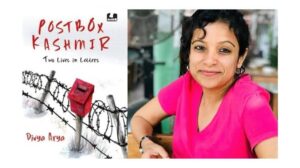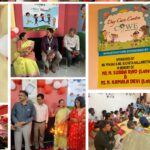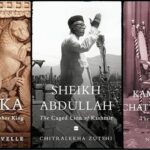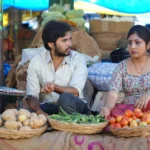The book ‘Postbox Kashmir: Two lives in letters’, traces the journey of two teenager pen pals, one in Srinagar and one in Delhi, and the politics of Kashmir.
Do only Muslims live in Kashmir? Why do girls in Kashmir do stone-pelting? Can you imagine being confined to the four walls of your home with no internet, no social media? Are Kashmiris really invisible to the rest of the country?
 These are some of the questions two teenagers – Saumya Sagrika in Delhi and Duaa Tul Barzam in Kashmir – asked each other through letters. Author, a BBC journalist Divya Arya experiments with the form as she uses the letters and the question and answers to sketch the non-fiction narrative of the politics of Kashmir and India, look back into history and a reflection on the current times. The book attempts to answer questions that young India would like to ask, especially in understanding the politics of Kashmir.
These are some of the questions two teenagers – Saumya Sagrika in Delhi and Duaa Tul Barzam in Kashmir – asked each other through letters. Author, a BBC journalist Divya Arya experiments with the form as she uses the letters and the question and answers to sketch the non-fiction narrative of the politics of Kashmir and India, look back into history and a reflection on the current times. The book attempts to answer questions that young India would like to ask, especially in understanding the politics of Kashmir.
The book is published by Penguin Random House imprint, Duckbill and hit stores on August 5, the second anniversary of the revocation of Jammu & Kashmir’s special status.
Here is an excerpt from the book…
Saumya’s questions were innocent and honest. She wanted to understand.
I couldn’t understand one thing—why did the army attack those girls? Army is for our safety, right?
The Indian armed forces are a hallowed institution. They represent an idea beyond the individual. For the greater common good. Men and women, who choose to train to be physically and mentally tough enough to fight, kill or even die. Sacrifice their life for the nation. To defend its borders, its people.
Saumya had grown up watching an elaborate parade on 26 January, India’s Republic Day, every year. It was a winter morning ritual common across millions of homes in the country. Over rounds of tea and breakfast they watched the more than three-hour-long live broadcast that went through the same motions every year but never tired its viewers. In fact, the routine built a bond. When the President would unfurl the national flag, stand in salute, the national anthem would be played, and Saumya would leave her favourite spot on the sofa in front of the television in her house and jump into attention too, singing along till the end. A moment of patriotic fervour.
As columns upon columns of soldiers would march on, her chest swelled up in pride. And eyes welled up when she heard the battle accounts of the bravehearts being honoured with the likes of Shaurya (courage), Vir (brave), Kirti (glory) Chakras, the titles underscoring their heroism. Sometimes these were accepted posthumously by their wives, sisters, mothers. Who stood stoically, as they awaited their turn, fighting a million memories tearing their heavy heart.
There was another factor that influenced Saumya’s relationship with the Indian army. Her parents used to work at a petrol pump, whose owner was a war widow. Her husband had been martyred during the Kargil stand-off in Kashmir in 1999, when India and Pakistan came head-to-head in a warlike situation. On 26 July 1999, the Indian army successfully recaptured all the posts that had been occupied by Pakistan’s army. Since then that day was marked every year as Kargil Diwas (Kargil Day) to remember Indian soldiers’ sacrifices. Saumya grew up witnessing the annual commemoration on Kargil Diwas and said it instilled a sense of pride in her young mind. She felt attached to the Indian army. Knowing the family of an army man made their sacrifices for the country feel very close and real.
Saumya’s references clashed with the picture that Duaa’s letter evoked. And it wasn’t just the letter, as she engaged more with Kashmir, she could not escape the reports of pellet gun injuries, pictures of bloodied protestors of her own age that filled the newspapers and TV bulletins those nights, telling the story of the fight with the ‘internal’ challenge. When the army was engaging with its country’s own citizens and not an external enemy across the border.
Duaa had clarified in her letter that in the particular clash with the girls’ football coach that Saumya referred to, it was the police and not the army that was involved. The state police is a force made up of locals while the army is made up of soldiers from all over the country. And the army has been deeply involved in Kashmir. Not just in defending the borders of the state (and the country) with Pakistan and China in times of war but also as a force for maintaining internal peace and security. The army is assisted by the two paramilitary forces, the Border Security Force (BSF) and the CRPF. They have been inside Kashmir for more than three decades now. Hundreds of thousands of jawans are stationed across the state. It is an unusual sight for anyone who has not lived there. But for Duaa, who grew up witnessing that constant presence in Srinagar, it felt usual. She told me that she had gotten used to seeing them, that it did not matter and that she had learnt to ignore it.
They stood, with their rifles facing down. Inside the big cities, towns, villages. In their marketplaces, in neighbourhoods, on the roadside. Many times in bunkers, so omnipresent that they have become landmarks. Often cited by residents while giving directions, just as one would mention a traffic light or a shop. That’s how numerous they were when they started getting built in the 1990s. There are no official figures of how many were built, but estimates suggest they were in hundreds. They were a symbol of the state when the government was struggling in the face of an armed rebellion. Over the past decade or so, several bunkers were removed from Kashmir to reduce the visible security presence there. But in many mohallas, their memory lingers.
…
History gives perspective. For generations like those of Duaa—born after the insurgent 1990s, after militancy had been brought under control, after daily violence had ebbed, but while the presence of the forces persists, and a new rebellion rears its head at the horizon stirring alive latent fears—it brings a conundrum: should one inform one’s life and opinions by what they are witnessing in the present or by what has been recorded in words, songs and memories of the past? To look ahead to the future or look back at the history.
And in Kashmir, it is still not easy to reveal where you are looking. Feigned ignorance or a refusal to take a strong position is often a safe place. Not denying the past or one’s personal experience of it, but refusing to publicly acknowledge its lasting influence.
To enable dreaming of a safe future. It’s a silent and difficult choice.
The extract is published with permission. To order the book online click on the below mentioned link












